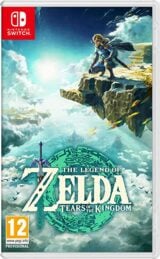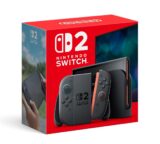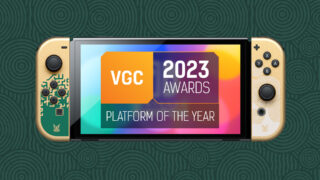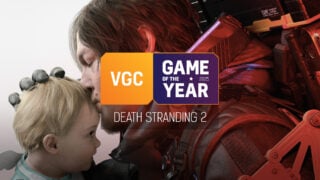Hey Nintendo, quick question regarding Tears of the Kingdom:
— Josh Scherr (@joshscherr) May 15, 2023
how in the fuck did you make this
VGC’s Developer of the Year 2023 is Nintendo EPD
With two Game of the Year candidates and a long-awaited sequel, Nintendo’s main division had a tremendous 2023

It goes without saying that if a developer manages to release a Game of the Year contender, that year has to go down as a success.

Consider, then, that Nintendo EPD has not only released two viable candidates for the title of this year’s best game, but also given us the best entry in a series that’s been dormant for a decade. With 12 months like that under its belt, it’s little wonder that Nintendo EPD is VGC’s developer of the year.
The first part of EPD’s three-pronged attack came in the form of the sequel to one of the highest-rated video games of all time, The Legend of Zelda: The Breath of the Wild. There was always every chance that Tears of the Kingdom would struggle to live up to its predecessor’s lofty heights, but instead it climbed even higher, both literally and figuratively.
The addition of new areas up in the clouds and deep underground gave the sequel a more varied mix of biomes (and the latter added the extra challenge craved by those who had mastered the first game), but it was the addition of Link’s five new abilities that proved to be literal game-changers – most notably, the new Ultrahand technique.
By combining Ultrahand with the Zonai devices found around Hyrule, players could put together all manner of unique tools, vehicles and other doo-hickeys. It was a concept that had been done before – some players likened it to Banjo Kazooie Nuts ‘n Bolts – but never so well.

It’s a testament to EPD’s utterly watertight commitment to execution that this building feature, with all its moving parts, could very easily have been a buggy mess but was instead so perfectly handled that even other developers took to social media to bestow such accolades on it as “the game programming flex of all time”.
Just two months after the release of Tears of the Kingdom (let’s just skip blissfully past Everybody 1-2-Switch), another long-awaited Nintendo EPD production was released – the first brand new Pikmin game in a decade.
Pikmin 4 somehow managed to achieve what no other entry in the series had accomplished before it – it catered to all needs. Previous Pikmin games offered frequently demanding strategy gameplay and weren’t particularly accessible, which is likely why the series had never sold amazingly well in the past.
The fourth game caters for this by removing previous gimmicks like 30-day limits and food supplies, and walling off its more challenging content away from the main story for those willing to put the time in.

Then, around 10-15 hours in, just as the Venn diagram of ‘newcomers who are now used to it’ and ‘veterans who hope this isn’t just more of the same’ touched its circles, the game’s second half presented itself, tossing in all manner of new ideas and challenges.
The results spoke for themselves – Pikmin 4 became the best-selling game in the series, outselling every other entry in just its first two months. The growth was particularly notable in its native Japan, something VGC can attest to first-hand when, during our coverage of the BitSummit indie festival, we frequently saw Pikmin advertisements and product tie-ins all over the country.
Basically, how many other developers this year can claim to have a game that had a sandwich named after it? A questionable sandwich, granted, but a sandwich nonetheless.
A worthy sequel to one of the greatest games ever made and a new high point in a cult favourite series would be considered a superb year for any developer, but the final round of Nintendo EPD’s 2023 salvo was arguably its most important.
New Super Mario Bros was released in 2006, and in the 17 years that have followed players have been served variations on the same theme. New Super Mario Bros Wii, New Super Mario Bros 2 and New Super Mario Bros U were all different hats sitting on the same head.
What’s more, the last truly new instalment, New Super Mario Bros U, was released 11 years ago, with subsequent diversions like the New Super Luigi U DLC and New Super Mario Bros U Deluxe acting as little more than exercises in kicking the can down the road.
With Super Mario Bros Wonder, Nintendo EPD not only delivered the first brand new 2D Mario side-scroller in more than a decade, it did so with a level of creativity and disregard for convention not seen since Super Mario Galaxy.
“With Super Mario Bros Wonder, Nintendo EPD not only delivered the first brand new 2D Mario side-scroller in more than a decade, it did so with a level of creativity and disregard for convention not seen since Super Mario Galaxy.”
From the jaw-dropping animations of both the heroes and the villains (we love the way Goombas look up in fear just before Mario lands on them) to the introduction of the Wonder Flower – which gives EPD’s designers carte blanche to throw any unique ideas it wants into the game, safe in the knowledge they’ll only last a single stage – Super Mario Bros Wonder is the Everest of the Himalayas that is the 2D Mario series, a particularly high point in a series where high points are the norm.
The overall result is a year in which all three games – The Legend of Zelda: Tears of the Kingdom, Pikmin 4 and Super Mario Bros Wonder – would have marked a strong year for any developer had they been released on their own, but stand as a monumental accomplishment when released within the same 12-month window.

The last time EPD pulled off something like this was in the Switch’s launch year of 2017, when it released Breath of the Wild, Mario Kart 8 Deluxe, Arms, Splatoon 2 and Super Mario Odyssey all within the end of the year. A barrage like that can only be delivered with years of advance planning.
We all know there’s a successor to the Switch on the way, and we all know Nintendo‘s teams – with EPD almost certainly front and centre – will already be hard at work on games for that successor, in preparation for another steady stream of quality titles.
The most exciting thing, then, isn’t that EPD has managed to once again release numerous gems in one year, hitting Metacritic scores of 96, 94 and 87 when many other developers would kill to hit just the latter of those at any point in their history.
It’s that, given the preparations inevitably already underway for Nintendo’s next console, there’s every chance it’s going to repeat the feat in the future.














